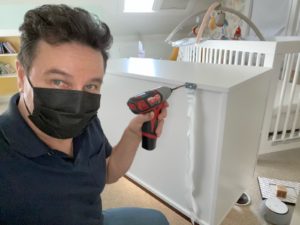Conduct Your Own Home Assessment
Conduct Your Own Home Assessment

GooGooproof provides childproofing assessments as a first step in our hazard reduction process by creating a childproofing plan of action. Below is an outline of our process. We hope it helps you complete your project from start to finish. Having a logical process for any project increases success. The following information represents our opinion which is based on our installation experience, feedback from our clients and research of statistical data provided by Consumer Product Safety Commission (https://www.cpsc.gov/).
Risk Survey Outline
STEP ONE
Sit down and have a 10–15-minute brainstorming session. Include family and friends if possible. The more eyes and ears the better.
- Define your greatest safety concerns. Just list three things that are the largest concern to you right now.
- Think about some basic parts to your home like stairs, windows, and cabinets.
- Getting into the right mindset will help you understand what you’re up against. Watch these three short video clips to better understand how rapid the development of a toddler is and how fast they can overcome obstacles.
STEP TWO
Decide which medium you’ll be using to record the findings of your safety survey and have it ready to go before you start.
- Pen and paper works just fine for this project.
- Text documents can be shared with other family members.
- Spreadsheets can be a great tool to separate tasks, products, costs and areas of your home and create totals.
STEP THREE
Systematically walk through your entire home identifying hazards and creating notes using your chosen recording method. Don’t forget the garage, patios, decks and yards.
- Mapping out in your mind the survey route beforehand saves time and reduce distractions.
GooGooProof usually begins the home hazard survey at the front door or entrance area. From there we usually end up in the living room or den and continue through to the dining and kitchen areas including mud rooms, porches and butler pantries.
The greatest portion of storage units are usually found in the kitchen area. Spend some time here and make sure not to overlook anything. The final sections of your home includes sleeping areas, exercise areas or media rooms. The sleeping quarters are usually located in a separate section from the home like a top floor.
Basic Hazards You’ll Be Looking For
Furniture: Tip-Over Hazards
- Dressers need to be a top priority. Even a dresser in a room that will not be used needs to be added to your anchoring list. Nightstands may or may not be considered dressers. If they have drawers, even if they’re very low to the ground, they are a tip over hazard. In our estimation night stands are just small dressers.
- Bookshelves are inherently dangerous. They’re narrow, usually full of heavy items and the shelves are like a ladder for adventurous toddlers. They should definitely be added to your anchoring list.
- China closets, armoires or other huge and hard to move furniture needs to be anchored and should be identified in your survey. It can be anchored using pad eyes screwed to a piece of the framework on the top of the unit, pad eyes screwed into wall studs and then the two pad eyes connected with cable ties. Here’s a short video giving you a glimpse of what that looks like.
- Appliances; Cooking ranges need to be anchored to the wall or floor.
Storage Unit Contents (cabinets & drawers)
- Cabinets and drawers located throughout your home are found in media units, console tables, nightstands, bathroom vanities, garages, offices and kitchens. Contents of these storage units must be evaluated for hazardous items. Hazardous contents need to be relocated or latches installed. Contents that should be identified include, but not limited to, the following:
- Plastics
- Plastic wrap
- Plastic bags
- Garbage bags
- Poisons
- Spices
- Any food
- Dish washer soap
- Any cleaning products
- Sharp Objects
- Cutlery
- Blenders
- Plates: can break making a dagger shard of glass…etc..
- Pencils and pens
- Etc………
- Ropey objects that can be wrapped around a little persons neck
- string or rope of any kind
- cords from appliances
- plastic wrap
- Heavy objects
- Cast iron pots can be pulled off the shelf and land on little fingers.
- appliances with cords are easy targets to be pulled down
- Plastics
Fall Hazards
- Windows: Are your windows located where there is a fall hazard? How high above the ground are they? There are several ways to address various types of windows.
- Windows can slide up and down or side to side.
- Windows with crank actions or tilt-out designs require specific solutions.
- Bannisters
- Some may have horizontal balusters that create a stair like effect. Plexiglass panels or rolled acrylic sheeting attached to the railing can be a great solution.
- Some older bannisters have gaps between the balusters that are greater than 4″. The current building code requires 4″ or less.
- Stairs
- Baby gates installed across the top and bottom entrance of stairways can mitigate the risk of falls down stairs.
- Stair tread, non-slip pads, can reduce slippage on hard wood treads.
- Windows: Are your windows located where there is a fall hazard? How high above the ground are they? There are several ways to address various types of windows.
